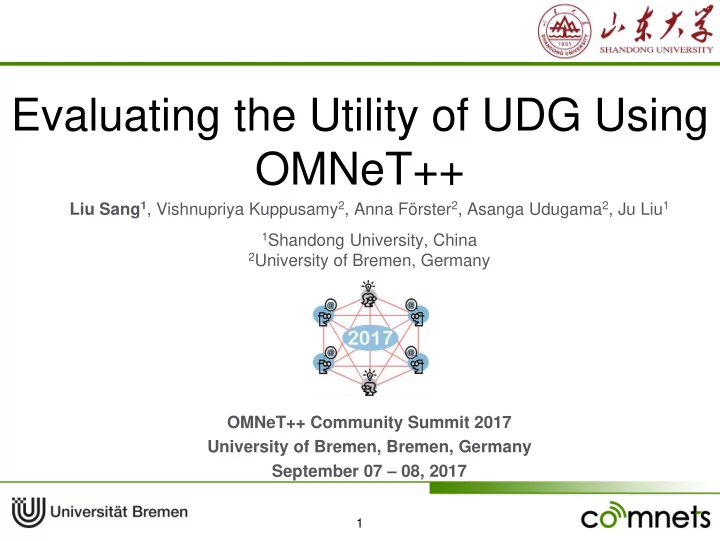

Evaluating the Utility of UDG Using OMNeT++ Liu Sang 1 , Vishnupriya Kuppusamy 2 , Anna Förster 2 , Asanga Udugama 2 , Ju Liu 1 1 Shandong University, China 2 University of Bremen, Germany OMNeT++ Community Summit 2017 University of Bremen, Bremen, Germany September 07 – 08, 2017 1
Outline Background Motivation Implementation Data Collection Trace based Mobility Model UDG Model Simulation Results Conclusion 2
Background Opportunistic Networks Contact Time Traces??? 3
Motivation Mobility Model Connectivity Model Contact Time Traces Trace Based Mobility Model More realistic | GPS based UDG Connectivity Model Simplest Used by simulators (ONE, Adyton) Is UDG model realistic??? UDG: Unit Disk Graph 4
Main Idea GPS file Input Real-world Simulation OMNeT++ (Trace based mobility model + UDG model) Output VS. Contact time traces BLE file BLE: Bluetooth Low Energy 5
Data Collection Android Application : BluetoothContacts * 22 users, 6 weeks GPS file GPS coordinates | Interval 10 mins Gauss - Krüger map projection Convert: Cartesian coordinates BLE file Received beacons | Interval 22 secs (unfixed) Threshold = 90 secs Convert: Contact times *BluetoothContacts: developed by Jens Dede and Sarmad Ghafoor, ComNets, Uni-Bremen, Germany. https://play.google.com/store/apps/details?id=de.uni_ bremen.comnets.BluetoothContacts, 6
Trace based Mobility Model Current Position Next Trace Position ** Functions readWaypointsFromFile(int nodeId); setTargetPosition() override; setInitialPosition() override; TraceBasedMobility Model Inheritance Diagram in INET ** INET framework is the library in OMNeT++ that includes all the protocols from physical layer to application layer. 7
UDG Model Users contact within wireless range Only depend on wireless range Unit Disk Graph 8
Scenario Setting Network: 5 users, 1 weeks. Colleagues Every day lunch time for 2 hours; Saturday/Sunday no work 9
Neighbour Availability Situations Fig. 2 Four Different Neighbour Availability Situations between Two Users - based on BLE and Simulations (with GPS Traces) 10
Absolute Difference of Contact Times N - users K - parts of simulation T S - contact time of sim T B - contact time of BLE T - simulation time Fig. 3 Absolute Difference of Contact Times against Wireless Range. 11
Average Contact Times per Hour Fig. 4 Average Contact Times per Hour against Wireless Range. 12
Histogram of Contact Times Fig. 5 Histogram of Contact Times. (Range = 20 m, 30 m and 40 m) 13
Conclusion Contact times from simulation based on UDG model follow the same pattern as contact times from Bluetooth traces. UDG should be effective as a connectivity model and thus, is suitable to extract contact times from GPS traces in simulations. 14
Thank you 15
Recommend
More recommend